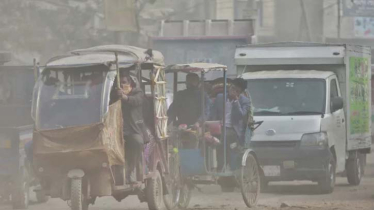
Photo : Messenger
Hopes for the Red Sun finally glimmer lights over landlocked northeast India and plans to connect with landlocked states with Bangladesh, which has been deemed as geostrategic significance to Japan.
Japan after the brutal Second World War has developed several proven friends of South Asia and is edging closer to Bangladesh and India for socio-economic development.
Many think tanks say Japan has enlarged its diplomatic vision in a bid to counter the economic hegemony of China, which has set its eyes towards South Asia.
Well, Japan has been a major donor and development partner since the war-ravaged Bangladesh, 52 years ago and has a strategic understanding of the region and the Bay of Bengal.
Against the backdrop of huge Japanese investment in the country recently being outsmarted by China, particularly after the launch of Beijing’s controversial Belt and Road Initiative (BRI), and half of South Asia including Bangladesh, Pakistan, Nepal and Sri Lanka are signatories of the mega plan to revitalise the ancient silk roads to the heart of the world.
A series of top Japanese official's visits to New Delhi, Guwahati (Assam), Agartala (Tripura) and Dhaka come against the background of Japan’s Free and Open Indo-Pacific (FOIP) Vision.
These developments in conjunction with initiatives like the Quad (Quadrilateral Security Dialogue) and regressive naval exercises jointly by the United States, Japan and Australia in the disputed South China Sea off the Philippines in response to a recent show of Chinese aggression in the disputed waters.
Japan wants her physical presence in the Bay of Bengal. As Nikkei Asia writes, Bangladesh's ambitious deep-sea port promises a strategic anchor for Japan and India.
A mega seaport under construction is shaping up to be a strategic linchpin for Japan and India as the Quad partners aim to counter Chinese influence.
Development of the gigantic port of Matarbari will put a Japan-backed facility just north of Sonadia, another prime location on the Bay of Bengal where China proposed to develop another port. The Chinese project never materialised, and Dhaka reportedly dropped the idea, reports Nikkei Asia.
A mega deep-sea port at Matarbari, in southeast Bangladesh waters is underway and is expected in 2027, the complex will take a major load off of the country's main Chattogram (formerly Chittagong) port and a trade gateway for northeast India, which would be less than 100 kilometres to the massive port facility.
Whatever the geopolitical strategy, the deep-sea port project has the potential to improve regional trade ties, boost investment, create jobs, and support infrastructural development, spurring economic growth for Bangladesh, Northeast India, Nepal, and Bhutan, as well as the surrounding countries along the Bay of Bengal.
Earlier regional studies suggested both Bangladesh and Northeast India need to scale up their multi-modal connectivity, which would not only help the region to raise its competitiveness but also narrow long-standing regional development gaps.
The connectivity will bring synergy in trade facilitation, and build express corridors for the trans-shipment and transit of goods from northeast India to Bangladesh port in Chattogram.
Currently, nearly 350 Japanese companies are operating in Bangladesh, with more than $380 million in combined investment.
Japanese investment in Bangladesh has reached USD 123 million in 2022. Japan and India are two major export destinations in Asia where Bangladesh's export earnings reached $2 billion, said a top official Ministry of Commerce.
Japan has proposed developing an industrial hub in Bangladesh with supply chains to the landlocked northeast states of India, Nepal and Bhutan beyond by developing a port and connectivity in the region.
Improve connectivity in the region through the Bay of Bengal Industrial Growth Belt (BIG-B) initiative, Japan plans to build road connectivity in the Indian states of Assam, Mizoram, and Tripura to connect to the seaport in the Bay of Bengal.
Calling India an ‘indispensable partner’, after Japanese Prime Minister Fumio Kishida listed three important regions — Southeast Asia, South Asia and the Pacific Islands — where multi-layered connectivity could overcome vulnerabilities and boost economic growth, writes Fumiko Yamada, a Research Associate at the University of Melbourne, Australia.
The comprehensive collaboration among Bangladesh, India and Japan provides the blocked-in northeast with access to the Bay and access to ASEAN countries, which plays a crucial role in unleashing the enormous potential for growth and prosperity based on better access to the Indian Ocean, becomes crucial for the improvement of people’s lives of the northeast region, opines Ishita Singh Bedi of Amity University in India.
The Red Sun has plans to build a Bengal–Northeast India industrial value chain in cooperation with India and Bangladesh to foster growth in the region.
Earlier in 2019, the Government of Japan invested 205.784 billion Yen, equivalent to approximately BDT 152 billion in several ongoing and new projects in different states of India’s northeast region. None of the projects would be sustainable unless the connectivity with Bangladesh is augmented to rip huge economic benefits.
Regarding port development, Japan could hardly ask for a better spot than Matarbari — a natural gateway to South and Southeast Asia. Tripura state, around 100 kilometres from the proposed seaport, might serve as a gateway for regional exporters, Bedi writes.
Japanese Prime Minister’s FOIP vision focused particularly on emerging economies and developing countries in the Indo-Pacific region and territories vulnerable to climate change and natural disasters.
It comes after Japanese Prime Minister Kishida visited India last March, where he touted the idea of a new industrial hub for the Bay of Bengal and northeast India that could bolster development in the impoverished region of 300 million people.
After Kishida visited India, Japan approved $1.27 billion in funding to Bangladesh for three infrastructure projects - including an enormous commercial port in the Bay, which will be equivalent to the Port of Colombo in Sri Lanka or the Singapore Port in terms of water depths, said a JICA official in charge of the project.
India and Japan have a comprehensive economic partnership, with trade worth $20.57 billion in 2021-2022. Of this volume, India imported Japanese goods worth $14.49 billion, reported Reuters.
The FOIP and new mega project investment further solidified when Bangladesh Prime Minister Sheikh Hasina visited Tokyo and held an official parley with Kishida in late April.
With infrastructure projects set to be completed over a five to ten-year horizon, the proposal for joint discussions on investment promotion, customs, and tariffs will set the stage for an economic boom in India’s northeast.
India, Japan, and Bangladesh need to create a mechanism to discuss three key stumbling blocks to regional investment: tariffs, customs procedures, and connectivity. India and Bangladesh are negotiating a Comprehensive Economic Partnership Agreement (CEPA) that is expected to boost bilateral trade.
Messenger/Fameema








